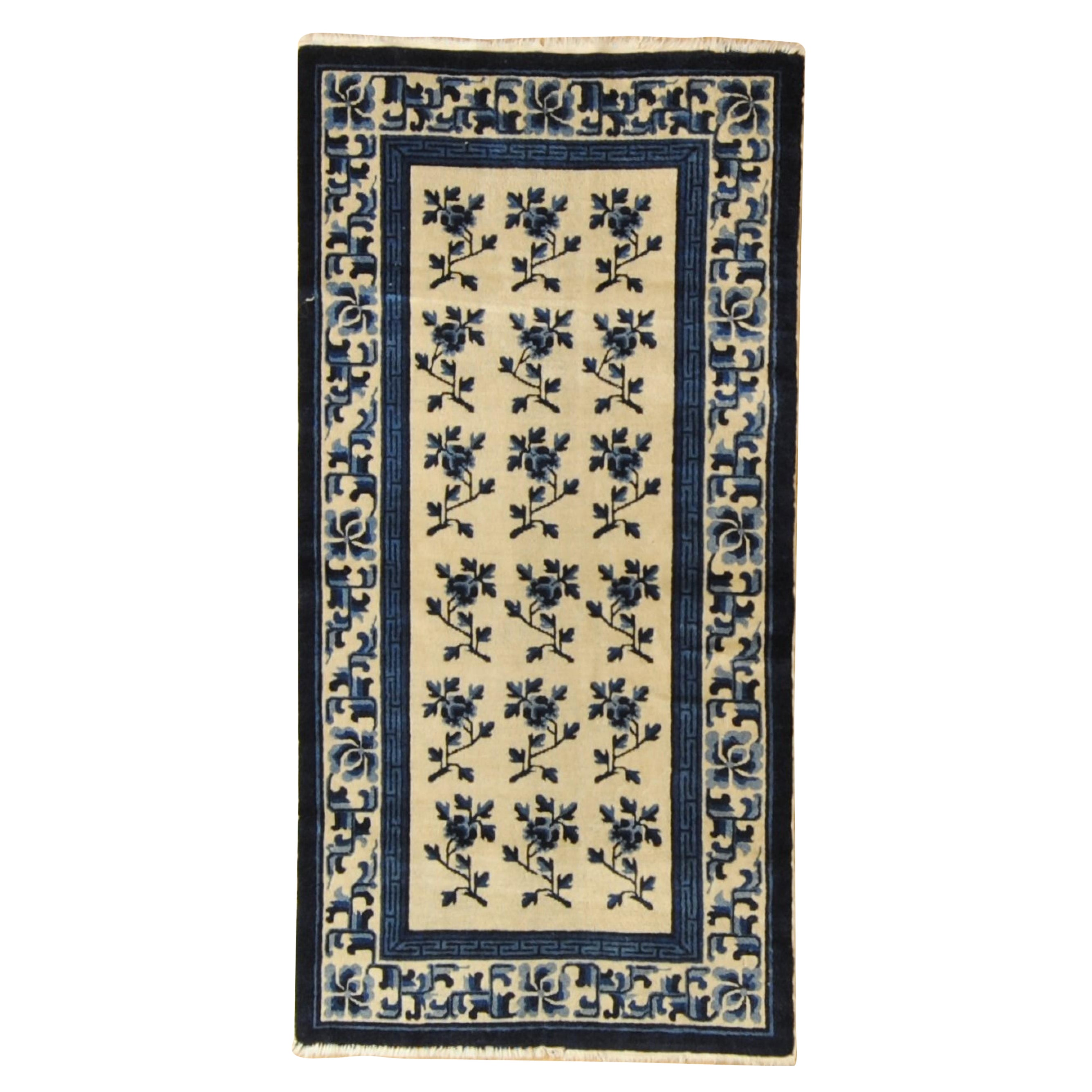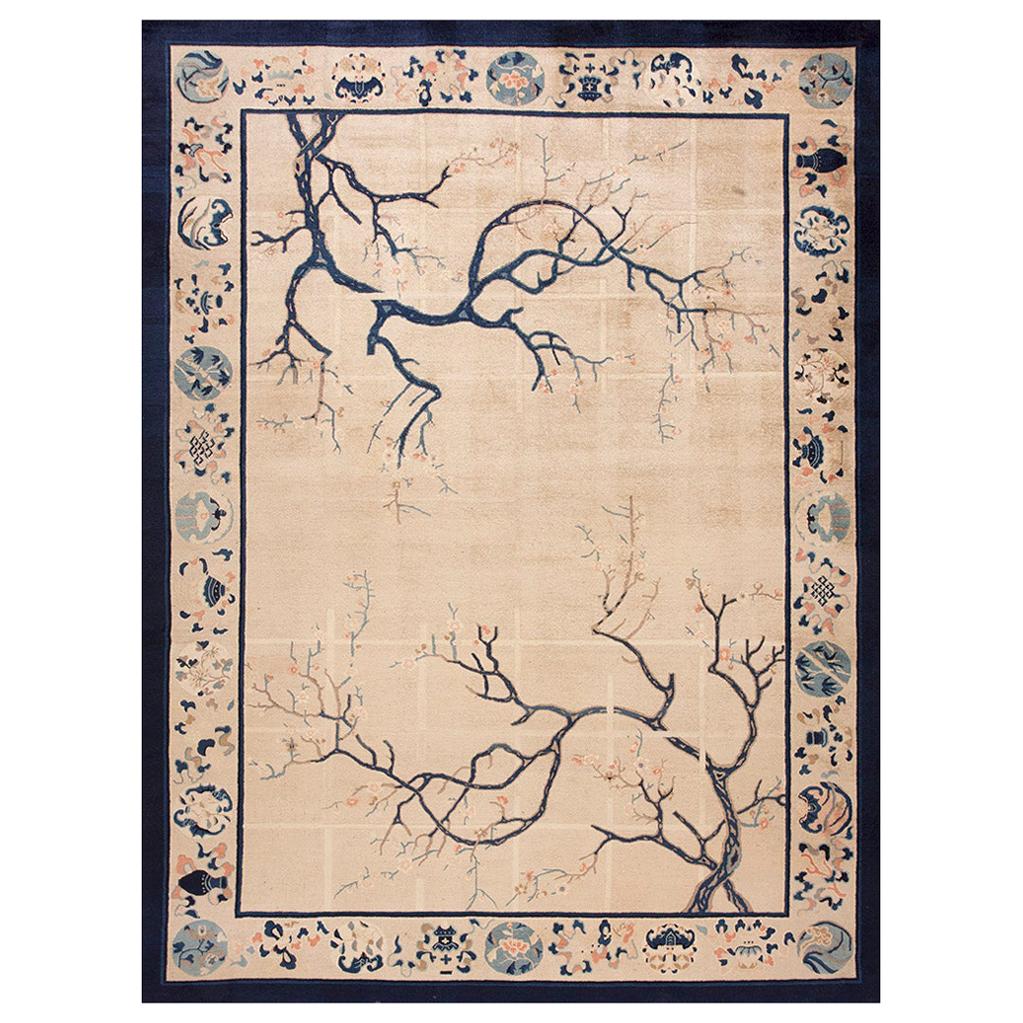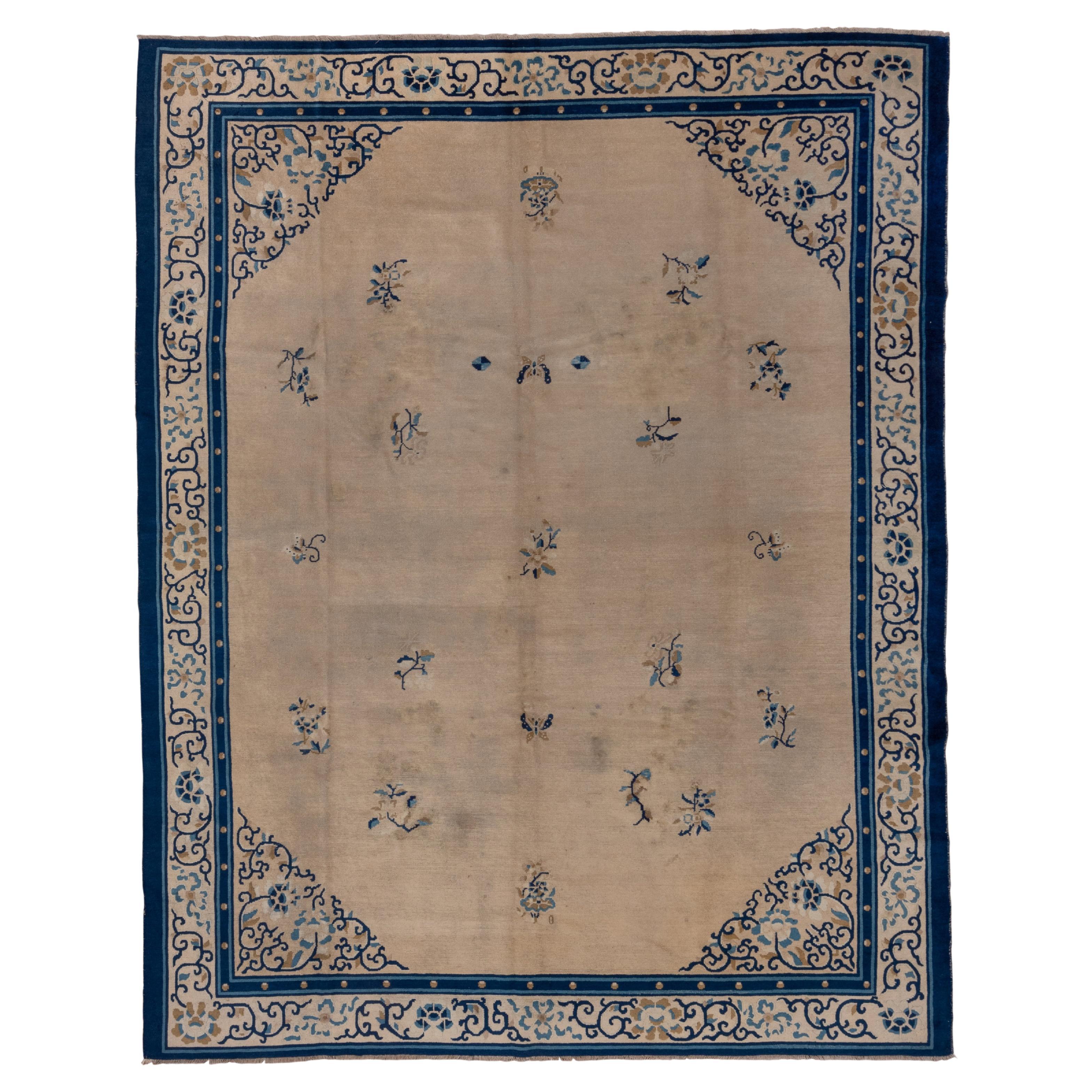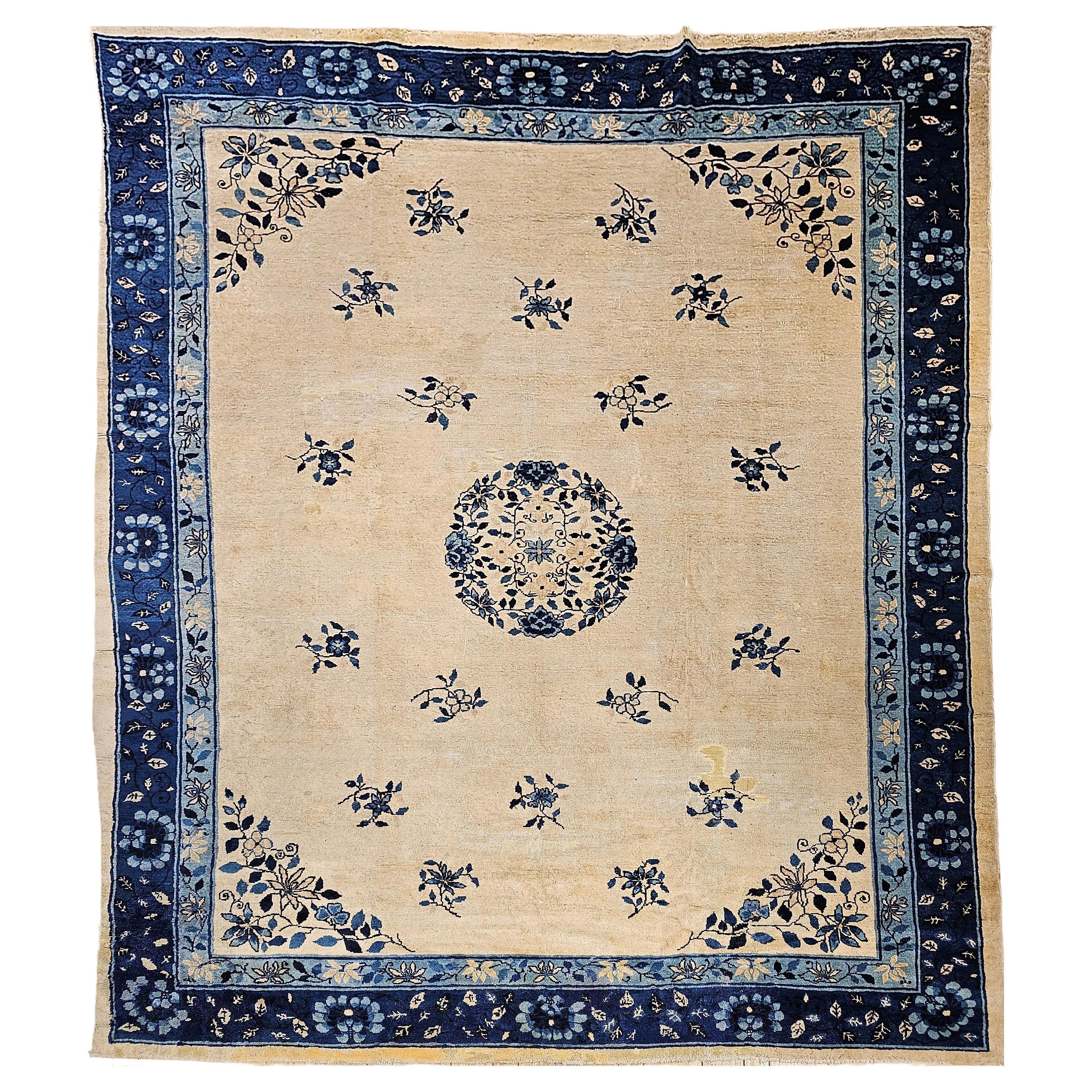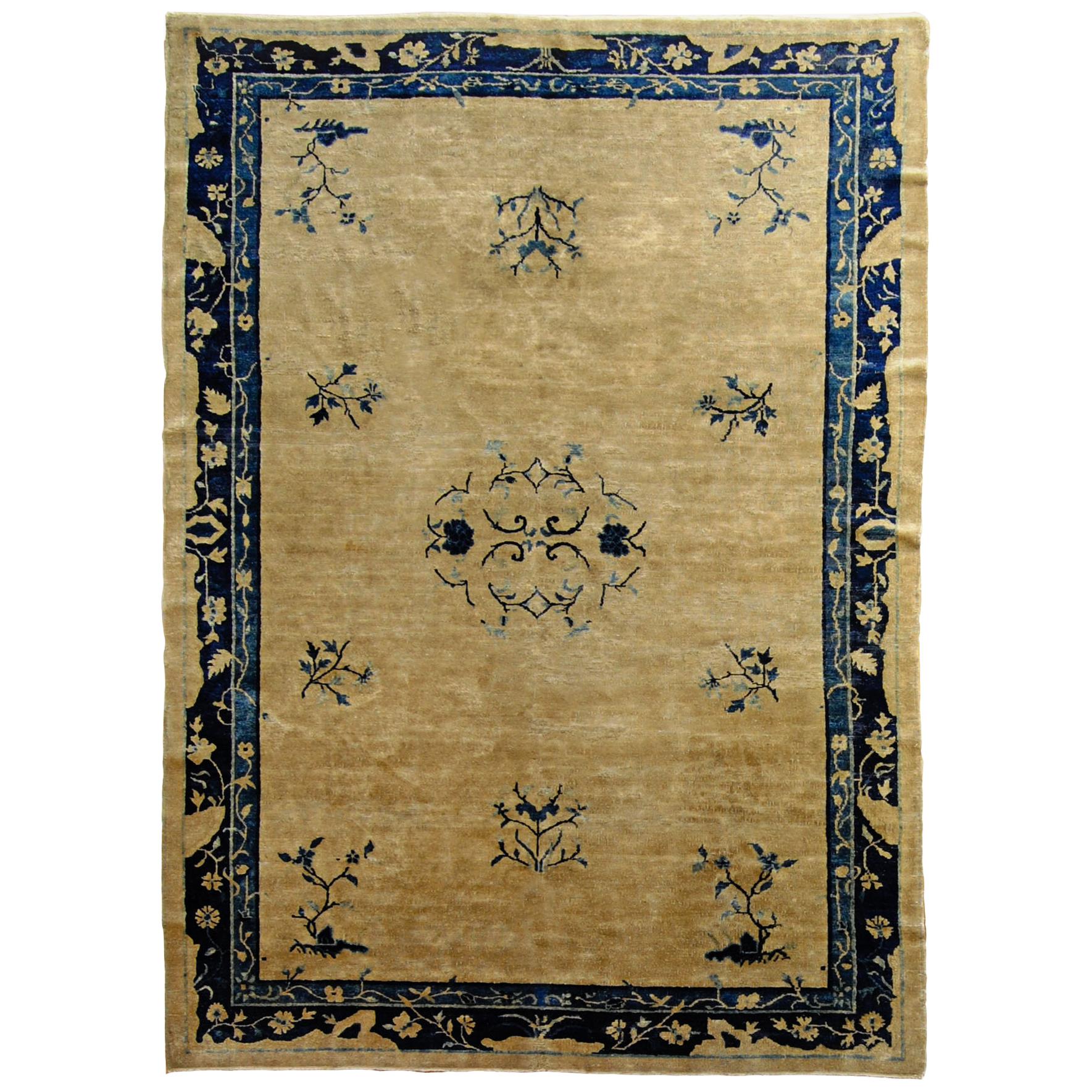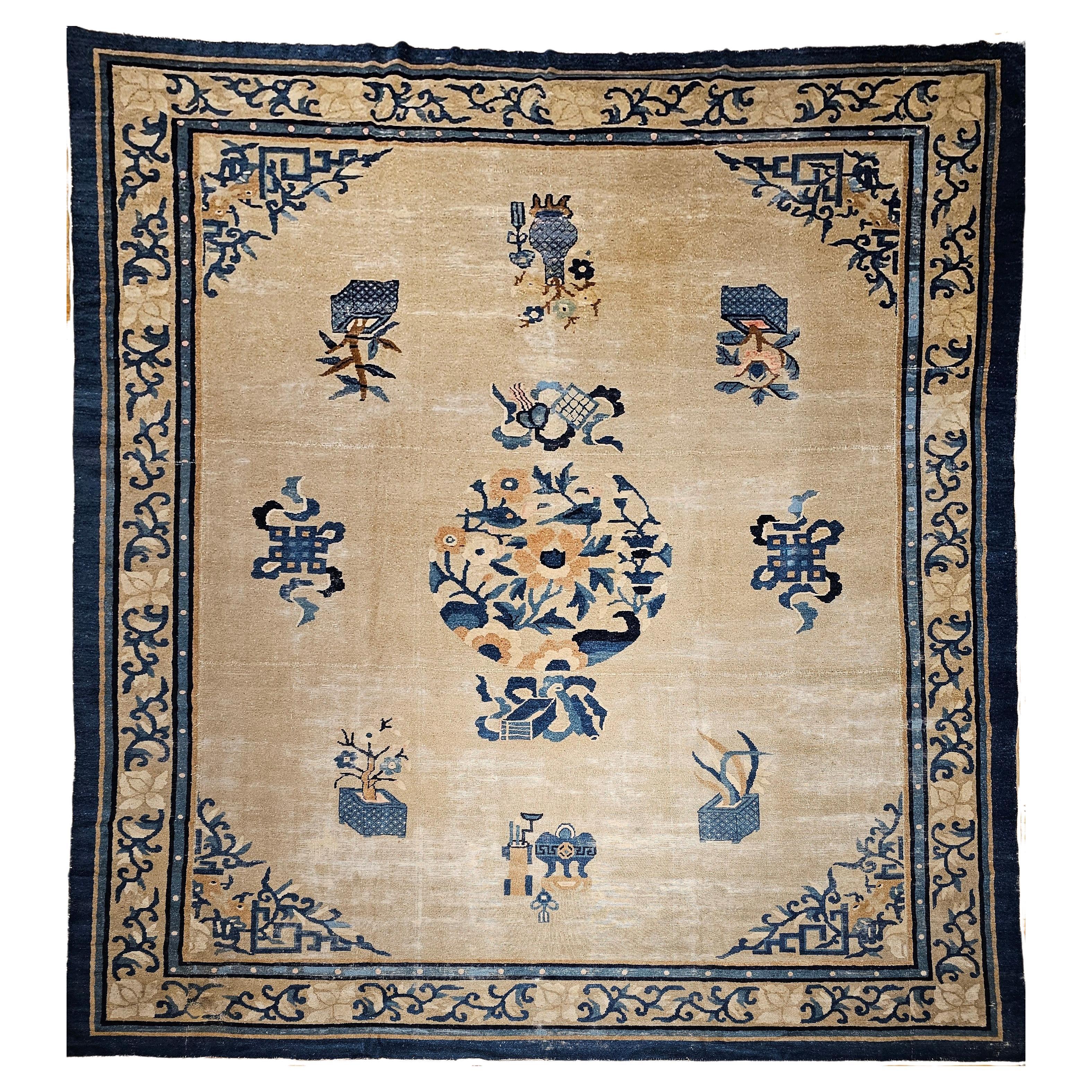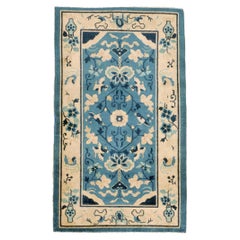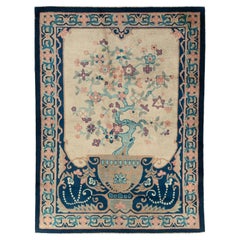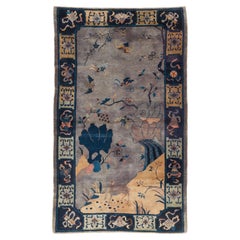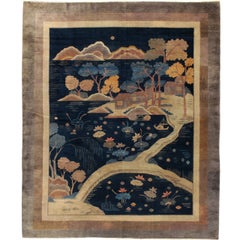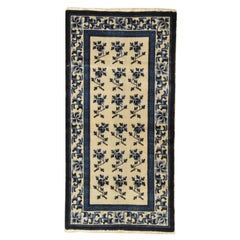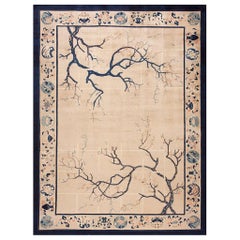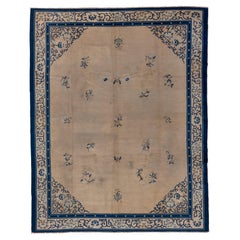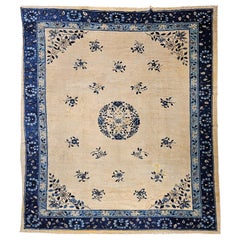Items Similar to Early 20th Century Handmade Chinese Peking Long Gallery Carpet in Cream & Blue
Want more images or videos?
Request additional images or videos from the seller
1 of 11
Early 20th Century Handmade Chinese Peking Long Gallery Carpet in Cream & Blue
$6,875
£5,104.32
€5,947.94
CA$9,544.72
A$10,676.37
CHF 5,556.05
MX$131,429.75
NOK 70,684.42
SEK 66,315.92
DKK 44,377.56
Shipping
Retrieving quote...The 1stDibs Promise:
Authenticity Guarantee,
Money-Back Guarantee,
24-Hour Cancellation
About the Item
An antique Chinese Peking long gallery carpet handmade during the early 20th century in shades of cream and blue.
Measures: 5' 9" x 16' 3"
The craft of the hand-knotted carpet in China, and the surrounding areas including Mongolia and Tibet, extends into the early centuries of the first millennium, C.E., but we really have a firm grasp only beginning in the later 16th century with large, very coarsely woven carpets, often depicting dragons, created for the Imperial Forbidden City palaces. Chinese carpets have always been commercial and there are no tribal groups responsible for any of the carpet weaving strains.
When the Ming Dynasty fell in 1644, with no Imperial patrons, production moved to the city of Ningxia in north central China where several workshops turned out more finely woven pieces for the Mandarins of the administrative Ch’ing bureaucracy and well-to-do merchants. Ningxia was the major Chinese carpet center up through most of the 19th century, with first allover and then medallion designs on cotton foundations in medium weaves. Palettes were initially limited to yellows, dark blue and cream, but later widened to include reds, browns and even green. These antiques were the first Chinese carpets to be exported to the West and they fitted in well with the craze for Chinese blue-and-white porcelain in the second half of the 19th century. Ningxia also wove shaped and rectangular small rugs for saddle underlays, chair (“throne”) seats and shaped backs, pillar carpets with dragons or monks for Buddhist monasteries, and long divided runners for monastery meditation halls. These small rugs are among the most collectible of all Chinese weavings.
Weavers from Ningxia set up workshops in the capital Peking (Beijing) in the 1860’s and began weaving Western room sizes for export, primarily to America. In blue – and – white and polychrome palettes, with round wreath medallions, precious objects, seasonal flowers, paeonies, lotuses, fretwork, clouds, butterflies and bats, all relatively spaciously drawn. The round “Shou” (Good Luck) character is also a prominent decorative motif. There are also a few Peking landscape pictorials with pagodas, houses, bridges, waterscapes and boats. Peking carpets were woven right up until WWII and production began again after the Cultural Revolution around 1970. They are moderately well-woven, on cotton foundations, exactingly executed and indisputably Chinese. Many are in the blue-and-white style. Nothing else looks like a Peking carpet and for a Chinese “look” in a room, they are absolutely indispensable. Sizes range from scatters and a few runners, through the popular 9’12’ size, to large carpets over 20’ which must have been special orders. The earliest Peking Revival carpets are pliable and fairly thin, but they became heavier and more compact in the 20th century, in competition with Art Deco carpets from Tientsin. The modern, post- 1970, pieces are in the traditional Peking style, but are a little too regular and neat. Exactitude has been favored over character, as hard to explain that as it is.
There are a number of all-silk and silk-and –metal thread pieces, many with inscriptions purporting to link them with rooms in the Imperial palaces, bringing very substantial auction prices, but none are really antique. The genre emerged after WWI and the present demand comes from mainland Chinese. The silk piles often stand in pattern relief against flat woven gold metal thread grounds. The inscriptions are apocryphal, the rugs are flashily opulent, perfect for nouveaux riches.
The Art Deco period between the two World Wars saw a distinctive carpet industry developing in Tientsin (Tianjin) in northeastern China. These are highly prized for their transitional design character, neither overtly Chinese, nor abstractly modern/contemporary. Woven exclusively for export, usually by and for American firms, such as Nichols and Elbrook, they are totally in the “Jazz Age Modern” style of the 1920’s, often without borders, with abstract or abstracted patterns, and only with, at best, a few Chinese-y pattern elements. Vases asymmetrically placed in the corners are features of some of the more Chinese-y carpets. Open fields with floral sprays and branches growing in from the edges are anther design innovation. Often, Chinese motives have been re-imagined in more sharp-edged, abstract manners. Some have no references whatsoever to natural elements. The patterns are sharp and the rugs are never subdued, soft or restrained. The rugs are heavily constructed, with crisp, unfading dyes and medium to medium coarse weaves on cotton foundations. All are extremely well-executed, with none of the vagaries, variations or twists found on even high-quality Persian rugs. The majority are in the 9’ by 12’ format and a surprising number can be found in top condition. There also was a substantial production in Peking from, especially from the Fette factory. Elliptical and round carpets, and lighter, often pastel colors, were a specialty. Nothing looks like an Art Deco Chinese and they work well with traditional Chinese furniture and the most modern decor as well. These is no substitute for a good Chinese Art Deco carpet.
Chinese carpets also include small scatters from Tibet, with high quality wool, floating dragons and allover textile patterns. The colors of vintage and modern pieces are bright, but there are antique small rugs (sleeping rugs) with simple chessboard allovers. Only a few large antique Tibetan carpets are known. Also grouped as Chinese are the boldly drawn, usually square large carpets assigned to Inner Mongolia. These look like Peking Revival pieces, but show fewer and larger patterns, usually with central medallions or “Shou” characters. They are generally fairly thin, on cotton foundations. Their exact origins are still mysterious.
Pictorial small rugs are woven in the town of Bao-Tou, with deer and Taoist Immortals. Scatters from the town of Suiyuan often show “grains of rice” small overall patterns.
Chinese rugs are all woven in factory settings, with numerous upright looms, and copious, drone-like weavers. There is no tradition of innumerable dispersed villages as in Persia or Turkey, or nomadic tribes as in Central Asia or Morocco. Rug weaving, like other Chinese art industries, is a commercial enterprise relying on an extremely efficient organization from wool selection to final finishing, geared to large-scale, uniformly high quality production. The resulting carpets are always well-executed and many rise to the level of real art.
- Dimensions:Width: 69 in (175.26 cm)Length: 195 in (495.3 cm)
- Style:Art Deco (In the Style Of)
- Materials and Techniques:Wool,Hand-Knotted
- Place of Origin:
- Period:
- Date of Manufacture:Early 20th Century
- Condition:Wear consistent with age and use.
- Seller Location:New York, NY
- Reference Number:Seller: 137081stDibs: LU882324459882
About the Seller
5.0
Platinum Seller
Premium sellers with a 4.7+ rating and 24-hour response times
Established in 1989
1stDibs seller since 2009
592 sales on 1stDibs
Typical response time: 1 hour
- ShippingRetrieving quote...Shipping from: New York, NY
- Return Policy
Authenticity Guarantee
In the unlikely event there’s an issue with an item’s authenticity, contact us within 1 year for a full refund. DetailsMoney-Back Guarantee
If your item is not as described, is damaged in transit, or does not arrive, contact us within 7 days for a full refund. Details24-Hour Cancellation
You have a 24-hour grace period in which to reconsider your purchase, with no questions asked.Vetted Professional Sellers
Our world-class sellers must adhere to strict standards for service and quality, maintaining the integrity of our listings.Price-Match Guarantee
If you find that a seller listed the same item for a lower price elsewhere, we’ll match it.Trusted Global Delivery
Our best-in-class carrier network provides specialized shipping options worldwide, including custom delivery.More From This Seller
View AllMid-20th Century Handmade Chinese Peking Throw Rug in Cream and Light Blue
Located in New York, NY
A vintage Chinese Peking throw rug handmade during the mid-20th century with a cream border and light blue field.
Measures: 2' 6" x 4' 3"
The craft of the hand-knotted carpet in China, and the surrounding areas including Mongolia and Tibet, extends into the early centuries of the first millennium, C.E., but we really have a firm grasp only beginning in the later 16th century with large, very coarsely woven carpets, often depicting dragons, created for the Imperial Forbidden City palaces. Chinese carpets have always been commercial and there are no tribal groups responsible for any of the carpet weaving strains.
When the Ming Dynasty fell in 1644, with no Imperial patrons, production moved to the city of Ningxia in north central China where several workshops turned out more finely woven pieces for the Mandarins of the administrative Ch’ing bureaucracy and well-to-do merchants. Ningxia was the major Chinese carpet center up through most of the 19th century, with first allover and then medallion designs on cotton foundations in medium weaves. Palettes were initially limited to yellows, dark blue and cream, but later widened to include reds, browns and even green. These antiques were the first Chinese carpets to be exported to the West and they fitted in well with the craze for Chinese blue-and-white porcelain in the second half of the 19th century. Ningxia also wove shaped and rectangular small rugs for saddle underlays, chair (“throne”) seats and shaped backs, pillar carpets with dragons or monks for Buddhist monasteries, and long divided runners for monastery meditation halls. These small rugs are among the most collectible of all Chinese weavings.
Weavers from Ningxia set up workshops in the capital Peking (Beijing) in the 1860’s and began weaving Western room sizes for export, primarily to America. In blue – and – white and polychrome palettes, with round wreath medallions, precious objects, seasonal flowers, paeonies, lotuses, fretwork, clouds, butterflies and bats, all relatively spaciously drawn. The round “Shou” (Good Luck) character is also a prominent decorative motif. There are also a few Peking landscape pictorials with pagodas, houses, bridges, waterscapes and boats. Peking carpets were woven right up until WWII and production began again after the Cultural Revolution around 1970. They are moderately well-woven, on cotton foundations, exactingly executed and indisputably Chinese. Many are in the blue-and-white style. Nothing else looks like a Peking carpet and for a Chinese “look” in a room, they are absolutely indispensable. Sizes range from scatters and a few runners, through the popular 9’12’ size, to large carpets over 20’ which must have been special orders. The earliest Peking Revival carpets are pliable and fairly thin, but they became heavier and more compact in the 20th century, in competition with Art Deco carpets from Tientsin. The modern, post- 1970, pieces are in the traditional Peking style, but are a little too regular and neat. Exactitude has been favored over character, as hard to explain that as it is.
There are a number of all-silk and silk-and –metal thread pieces, many with inscriptions purporting to link them with rooms in the Imperial palaces, bringing very substantial auction prices, but none are really antique. The genre emerged after WWI and the present demand comes from mainland Chinese. The silk piles often stand in pattern relief against flat woven gold metal thread grounds. The inscriptions are apocryphal, the rugs are flashily opulent, perfect for nouveaux riches.
The Art Deco period between the two World Wars saw a distinctive carpet industry developing in Tientsin (Tianjin) in northeastern China. These are highly prized for their transitional design character, neither overtly Chinese, nor abstractly modern/contemporary. Woven exclusively for export, usually by and for American firms, such as Nichols and Elbrook, they are totally in the “Jazz Age Modern” style of the 1920’s, often without borders, with abstract or abstracted patterns, and only with, at best, a few Chinese-y pattern elements. Vases asymmetrically placed in the corners are features of some of the more Chinese-y carpets. Open fields with floral sprays and branches growing in from the edges are anther design innovation. Often, Chinese motives have been re-imagined in more sharp-edged, abstract manners. Some have no references whatsoever to natural elements. The patterns are sharp and the rugs are never subdued, soft or restrained. The rugs are heavily constructed, with crisp, unfading dyes and medium to medium coarse weaves on cotton foundations. All are extremely well-executed, with none of the vagaries, variations or twists found on even high-quality Persian rugs. The majority are in the 9’ by 12’ format and a surprising number can be found in top condition. There also was a substantial production in Peking from, especially from the Fette factory. Elliptical and round carpets, and lighter, often pastel colors, were a specialty. Nothing looks like an Art Deco Chinese and they work well with traditional Chinese furniture and the most modern decor as well. These is no substitute for a good Chinese Art Deco carpet.
Chinese carpets also include small scatters from Tibet, with high quality wool, floating dragons and allover textile patterns. The colors of vintage and modern pieces are bright, but there are antique small rugs...
Category
Mid-20th Century Chinese Art Deco Chinese and East Asian Rugs
Materials
Wool
Collection Mid-20th Century Handmade Chinese Art Deco Accent Rug
Located in New York, NY
A vintage Chinese Art Deco accent rug handmade during the mid-20th century.
Measures:
Category
Mid-20th Century Chinese Art Deco Chinese and East Asian Rugs
Materials
Wool
Vintage Chinese Art Deco Accent Rug
Located in New York, NY
This mid-20th century Chinese Art Deco rug, measuring 4' 0" x 6' 8", presents an enchanting pictorial composition inspired by traditional Chinese landscape art. The soft gray field i...
Category
Mid-20th Century Chinese Art Deco Chinese and East Asian Rugs
Materials
Wool
Antique Chinese Peking Rug
Located in New York, NY
An antique Chinese Peking deco carpet from the first quarter of the 20th century.
Category
Vintage 1920s Chinese Chinoiserie Chinese and East Asian Rugs
Materials
Cotton, Wool
$12,600
Mid-20th Century Chinese Peking Inspired English Axminster Room Size Carpet
Located in New York, NY
A Chinese Pictorial Peking Inspired English Axminster Room Size Carpet handmade during the Mid-20th century.
Measures: 8' 11" x 11' 9"
Category
Mid-20th Century English Art Deco Chinese and East Asian Rugs
Materials
Wool
Early 20th Century Chinese Peking Large Room Size Rug
Located in New York, NY
An antique Chinese Peking large room size carpet handmade during the early 20th century.
Measures: 10' 10" x 15' 2".
Category
Early 20th Century Chinese Art Deco Chinese and East Asian Rugs
Materials
Wool
You May Also Like
20th Century Blue and White Floreal Peking Chinese Handmade Rug, ca 1930
Located in Firenze, IT
Old Chinese carpet of the city of Peking from the unusual format, elegantly decorated with branches of peony in bloom. For the oriental tradition, ...
Category
Early 20th Century Chinese Chinese and East Asian Rugs
Materials
Wool
Early 20th Century Ivory Chinese Peking Carpet ( 9' x 11'8" 275 x 355 cm )
Located in New York, NY
Early 20th Century Ivory Chinese Peking Carpet ( 9' x 11'8" 275 x 355 cm )
Category
Antique Early 1900s Chinese Chinese and East Asian Rugs
Materials
Wool
Antique Chinese Rug with Warm Ecru Field and Blue Design, Circa 1920's
Located in New York, NY
The warm ecru field presents a widely dispersed, symmetric layout of butterflies and small floral sprays, with deep, triangular vine arabesque corners anchored by petal peonies. Ecr...
Category
Early 20th Century Chinese Chinese and East Asian Rugs
Materials
Wool
Late 19th Century Chinese Peking Rug in Ivory Field and Navy, French Blue Border
Located in Barrington, IL
This vintage Chinese Peking rug from the late 19th century features a beautifully soft ivory field, showcasing traditional Chinese floral bouquets and a graceful central medallion in a delicate floral motif. Framed by a striking border in navy and French blue, the rug offers a harmonious blend of color and pattern.
The design is both serene and sophisticated, evoking a sense of calm reminiscent of Chinese water gardens and Japanese rock gardens. Its timeless simplicity and refined elegance make it highly desirable for collectors, designers, and tranquil interior spaces.
Whether placed in a living room, bedroom, or displayed as a wall tapestry, this hand-knotted Chinese Peking rug brings a sense of history, balance, and beauty to any setting.
Dimensions: 9' x 11' 4″
Date of Manufacture: 4th Quarter of the 1800s
Place of Origin: China
Material: Wool pile on a cotton foundation
Condition: Wear consistent with age and use
The Persian Knot Gallery, SKU 1019
Chinese, Peking Rugs, Peking Carpets, Antique Chinese Peking Carpets, Antique Peking Rug, Antique Peking Carpet, Chinese Rug Dragon, Peking Chinese, Chinese Pagoda Rug, Art Deco Chinese, Chinese Art Deco, Art Deco Rugs, Antique Peking Rugs, Vintage Art Deco Rugs, Rugs Art Deco, Art Deco Nichols, Chinese Carpet Dragon, Nichols Deco Rugs...
Category
Antique Late 19th Century Chinese Chinese and East Asian Rugs
Materials
Wool, Cotton
$7,630 Sale Price
22% Off
19th Century Peking Hand-Knotted White and Blu Luxury Decoration Rug
Located in Firenze, IT
These rugs are characterized by the elegance of the tones and the refinement of the design that is linked to the art of decoration of the blue white porcelain of the Ming period.
...
Category
Antique Late 18th Century Chinese Chinoiserie Chinese and East Asian Rugs
Materials
Wool
$4,714 Sale Price
20% Off
19th Century Chinese Peking Rug in Near Square Size with Fortune Symbols
Located in Barrington, IL
This exceptional Chinese Peking rug from the 4th quarter of the 1800s is a rare find—especially in its near-square shape, which enhances its versatility and presence. Woven in a rich wheat field color, the rug features symbolic and artistic elements that reflect traditional Chinese themes of fortune, prosperity, and longevity.
At the center lies a beautifully rendered medallion with two birds perched on tree branches, a classic symbol of harmony and happiness. This focal point is surrounded by a series of auspicious Chinese symbols, creating a visual rhythm that is both meaningful and serene.
The rug’s color palette includes elegant shades of baby blue, French blue, navy, brown, and antique ivory, giving the piece a soft, timeless sophistication. The lattice-style border and open field composition are reminiscent of 18th and early 19th century Ningxia carpets, known for their refined minimalism and spiritual elegance.
Dimensions: 10’ 3” x 11' 10”
Date of Manufacture: 4th Quarter of the 1800s
Place of Origin: China
Material: Wool pile on a cotton foundation
Condition: Wear consistent with age and use
The Persian Knot Gallery, SKU: 1898
Vintage Tibetan Rugs, Tibetan Antique Rug, Tibet Antiques, Antique Tibetan Carpet, Antique Tibetan Carpets and Rugs, Tibet Carpet, Ningxia Rug, Ningxia Carpet, Tibet Wool Rugs, Tibet Flower Rugs, Mongolia Rugs, Mongolia Carpets, Chinese Peking Rugs, Antique Peking Carpets, Antique Chinese Peking Carpets, Antique Peking Rug, Antique Peking Carpet, Chinese Rug Dragon...
Category
Antique 1890s Chinese Chinese and East Asian Rugs
Materials
Wool, Cotton
$7,630 Sale Price
22% Off
More Ways To Browse
Art Deco Gold Compact
Antique Persian 12 X 16 Rug
Kai Kristiansen Rosewood Nesting Tables
Kangaroo Table
Karl Drerup Enamels
Karl Springer Goat Skin Dining Table
Kartell Pink Chairs
Keyhole Rocker
Khmer Bronze Sculpture
Kilim Upholstered Ottoman
King Edward Silverplate
Kings Pattern Silver Plate
Kipp Stewart Bar
Kitchen Banquette
Klismos Aluminum
Knight In Shining Armor
Knights Lighter
Knoll Barcelona Couch
